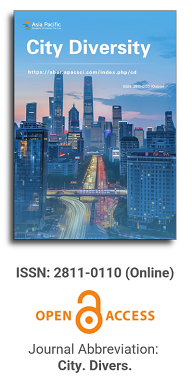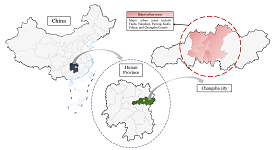
Asia Pacific Academy of Science Pte. Ltd. (APACSCI) specializes in international journal publishing. APACSCI adopts the open access publishing model and provides an important communication bridge for academic groups whose interest fields include engineering, technology, medicine, computer, mathematics, agriculture and forestry, and environment.

As China's pillar industry, the property market has suffered a considerable impact in recent years, with a decline in turnover and many developers at risk of bankruptcy. As one of the most concerned factors for stakeholders, housing prices need to be predicted more objectively and accurately to minimize decision-making errors by developers and consumers. Many prediction models in recent years have been unfriendly to consumers due to technical difficulties, high data demand, and varying factors affecting house prices in different regions. A uniform model across the country cannot capture local differences accurately, so this study compares and analyses the fitting effects of multiple machine learning models using February 2024 new building data in Changsha as an example, aiming to provide consumers with a simple and practical reference for prediction methods. The modeling exploration applies several regression techniques based on machine learning algorithms, such as Stepwise regression, Robust regression, Lasso regression, Ridge regression, Ordinary Least Squares (OLS) regression, Extreme Gradient Boosted regression (XGBoost), and Random Forest (RF) regression. These algorithms are used to construct forecasting models, and the best-performing model is selected by conducting a comparative analysis of the forecasting errors obtained between these models. The research found that machine learning is a practical approach to property price prediction, with least squares regression and Lasso regression providing relatively more convincing results.
Foreign human capital, cultural diversity and urban innovation in China
Vol 5, Issue 1, 2024
Download PDF
Abstract
From the perspective of cross regional flow of human capital, this paper studies the impact and mechanism of foreign human capital on urban innovation in China, and reveals the innovation effect of foreign human capital. The theoretical research shows that the efficient allocation of innovation elements brought by foreign human capital and the diversified externalities associated with it are the source for cities to maintain innovation vitality and competitiveness. The empirical study matching the individual micro data of Chinese census with the urban patent data found that foreign human capital has a significant role in promoting urban innovation, especially in the innovation of invention patents with the highest technological content. Further research on the mechanism reveals that the externality of cultural diversity brought by foreign human capital is an important channel to promote urban innovation. Therefore, the absorption and integration of foreign labor is the key to the city full of innovation and vitality.
Keywords
References
- Faggian A, McCann P. Human capital, graduate migration and innovation in British regions. Cambridge Journal of Economics. 2008; 33(2): 317-333. doi: 10.1093/cje/ben042
- Glaeser EL, Resseger MG. The Complementarity Between Cities and Skills. Journal of Regional Science. 2010; 50(1): 221-244. doi: 10.1111/j.1467-9787.2009.00635.x
- Caragliu A, Del Bo CF, Kourtit K, et al. The winner takes it all: forward-looking cities and urban innovation. The Annals of Regional Science. 2015; 56(3): 617-645. doi: 10.1007/s00168-015-0734-5
- Carlino GA, Chatterjee S, Hunt RM. Urban density and the rate of invention. Journal of Urban Economics. 2007; 61(3): 389-419. doi: 10.1016/j.jue.2006.08.003
- Lobo J, Strumsky D. Metropolitan patenting, inventor agglomeration and social networks: A tale of two effects. Journal of Urban Economics. 2008; 63(3): 871-884. doi: 10.1016/j.jue.2007.07.005
- Sedgley N, Elmslie B. Do We Still Need Cities? Evidence on Rates of Innovation from Count Data Models of Metropolitan Statistical Area Patents. American Journal of Economics and Sociology. 2011; 70(1): 86-108. doi: 10.1111/j.1536-7150.2010.00764.x
- Ottaviano GIP, Peri G. The economic value of cultural diversity: evidence from US cities. Journal of Economic Geography. 2005; 6(1): 9-44. doi: 10.1093/jeg/lbi002
- Lee N. Migrant and ethnic diversity, cities and innovation: Firm effects or city effects? Journal of Economic Geography. 2014; 15(4): 769-796. doi: 10.1093/jeg/lbu032
- Zhu Y, Tu Q. Industrial structure characteristics of global scientific and technological innovation centers-Evidence from 34 metropolitan areas in the United States. Urban development research. 2006; 12.
- Cao Y, Cao X, Luo C. Comparative Study on Innovation Capability and Its Influencing Factors of China’s Four Cities Directly Under the Central Government, China Soft science. 2013; 6.
- Wang M, Xuan Y, Chen Q. Creative Class agglomeration, knowledge externality and urban innovation-Evidence from 20 big cities. Economic theory and economic management. 2016; 1.
- Zhong X. Labor mobility and wage gap. China Social Sciences. 2006; 1.
- Chen Z, and Lu M. From segmentation to integration: political economy of urban and rural economic growth and social harmony. Economic research. 2008; 1.
- Cai F, Wang M. Why labor mobility has not narrowed the urban-rural income gap. Economic trends. 2009; 8.
- Meng X. Labor Market Outcomes and Reforms in China. Journal of Economic Perspectives. 2012; 26(4): 75-102. doi: 10.1257/jep.26.4.75
- Wan H, and Li S. The impact of registered residence discrimination on urban-rural income gap. Economic research. 2013; 9.
- Yuan Z. Rural-urban labor mobility and urban unemployment in China: an empirical study. Management world. 2006; 8.
- Liu X, and Zhao Y. The Impact of Labor Mobility on Urban Labor Market. Economics (quarterly). 2009; 2.
- Shen K, and Yu Ji. The impact of rural labor mobility on the income of Chinese urban residents—A Study Based on the perspective of urban and rural labor division in the process of marketization. Management world. 2011; 3.
- Liang Q, Chen Q, Wang R. Registered Residence Reform, Labor Mobility and Optimization of Urban Hierarchy System. China Social Sciences. 2013; 12.
- Du Y, Cai F, Qu X. Continuing China’s Miracle: Reaping Dividends from The Reform of The Registered Residence System. Economic Research. 2014; 8.
- Saxenian A. Silicon Valley’s New Immigrant High-Growth Entrepreneurs. Economic Development Quarterly. 2002; 16(1): 20-31. doi: 10.1177/0891242402016001003
- Peri G. The Effect of Immigration on Productivity: Evidence from US States. Review of Economics and Statistics. 2012; 94(1): 348-358. doi: 10.1162/REST_a_00137
- Hunt J, Gauthier-Loiselle M. How Much Does Immigration Boost Innovation? American Economic Journal: Macroeconomics. 2010; 2(2): 31-56. doi: 10.1257/mac.2.2.31
- Bosetti V, Cattaneo C, Verdolini E. Migration of skilled workers and innovation: A European Perspective. Journal of International Economics. 2015; 96(2): 311-322. doi: 10.1016/j.jinteco.2015.04.002
- Fassio C, Montobbio F, Venturini A. Skilled migration and innovation in European industries. Research Policy. 2019; 48(3): 706-718. doi: 10.1016/j.respol.2018.11.002
- Marshall A. Principles of Economics. London: Mac-Millan; 1890.
- Acs ZJ, Audretsch DB. Innovation and Small Firms. Cambridge, Massachusetts: Mit Press; 1990.
- Gennaioli N, La Porta R, Lopez-de-Silanes F, et al. Human Capital and Regional Development*. The Quarterly Journal of Economics. 2012; 128(1): 105-164. doi: 10.1093/qje/qjs050
- Eeckhout J, Pinheiro R, Schmidheiny K. Spatial Sorting. Journal of Political Economy. 2014; 122(3): 554-620. doi: 10.1086/676141
- Venables AJ. Productivity in cities: self-selection and sorting. Journal of Economic Geography. 2010; 11(2): 241-251. doi: 10.1093/jeg/lbq040
- Zhang C. What kind of city is more conducive to entrepreneurship. Economic research. 2018; 4.
- Card D. Immigrant Inflows, Native Outflows, and the Local Labor Market Impacts of Higher Immigration. Journal of Labor Economics. 2001; 19(1): 22-64. doi: 10.1086/209979
- Simonen J, McCann P. Firm innovation: The influence of R&D cooperation and the geography of human capital inputs. Journal of Urban Economics. 2008; 64(1): 146-154. doi: 10.1016/j.jue.2007.10.002
- Hart RA. Interregional economic migration: some theoretical considerations (PART II). Journal of Regional Science. 1975; 15(3): 289-300. doi: 10.1111/j.1467-9787.1975.tb00932.x
- Borjas GJ, Doran KB. The Collapse of the Soviet Union and the Productivity of American Mathematicians*. The Quarterly Journal of Economics. 2012; 127(3): 1143-1203. doi: 10.1093/qje/qjs015
- Kerr WUS. High-Skilled Immigration, Innovation, and Entrepreneurship: Empirical Approaches and Evidence. National Bureau of Economic Research. 2013. doi: 10.3386/w19377
- Wooldridge JM. Introductory Econometrics: A Modern Approach. England: South-Western Press; 2002. pp. 498-499.
- Peri G, Shih K, Sparber C. STEM Workers, H-1B Visas, and Productivity in US Cities. Journal of Labor Economics. 2015; 33(S1): S225-S255. doi: 10.1086/679061
- Ashraf Q, Galor O. The “Out of Africa” Hypothesis, Human Genetic Diversity, and Comparative Economic Development. American Economic Review. 2013; 103(1): 1-46. doi: 10.1257/aer.103.1.1
- Jacobs J. The Life of Cities. New York: Random House; 1969.
- Lazear EP. Culture and Language. Journal of Political Economy. 1999; 107(S6): S95-S126. doi: 10.1086/250105
- Moser LJ. The Chinese Mosaic: The Peoples and Provinces of China. Colorado: Westview Press; 1985. pp. 5-10.
- Du Y. Chinese personality map, Beijing: Jincheng publishing house; 2010.
Supporting Agencies
Copyright (c) 2024 Cui Zhang

This work is licensed under a Creative Commons Attribution 4.0 International License.

This site is licensed under a Creative Commons Attribution 4.0 International License (CC BY 4.0).

Prof. Mehmet Cetin
Kastamonu University,
Turkey
Polish Scientific Bibliography

